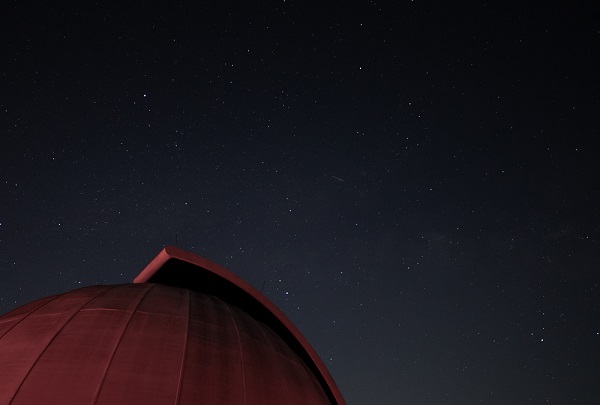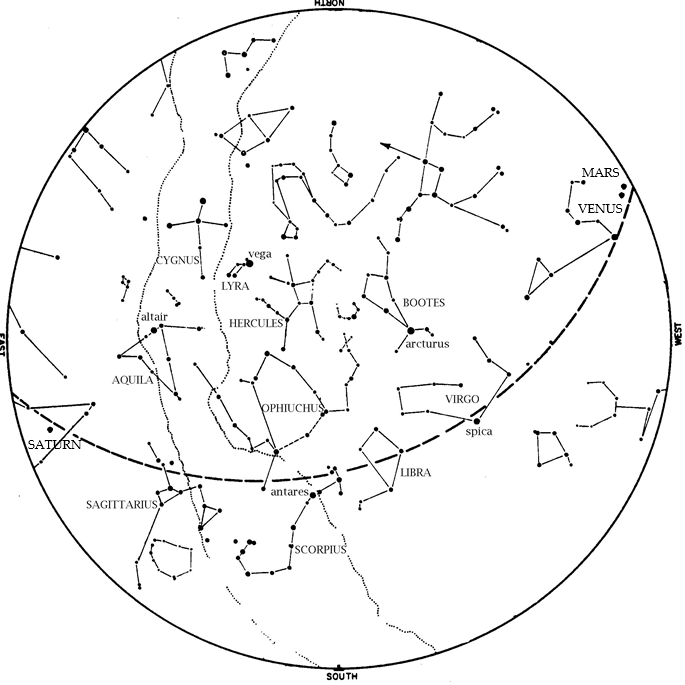Mars is still low in the west—visible right as night falls.
Venus remains in the evening sky this month. It overtakes Mars on July 12; the two planets appear about one half degree (the size of the Full Moon) apart that night. Venus outshines everything except the Sun and the Moon, so it is unmistakable low in the WNW at dusk.
Jupiter and Saturn are the morning sky this month, low in the southwest. However, these giants are also becoming late evening objects. Saturn rises in the east southeast by 10:20 on July 1 and in evening twilight by month’s end. On the night of August 1-2, Saturn is up literally all night long. Jupiter rises in the east southeast by 11:25 on July 1 and by 9:25 on July 31.

The Big Dipper is above and to the left of the North Star, with its handle pointing up. From that handle, you can ‘arc to Arcturus’ and then ‘speed on to Spica’; those stars are in the west at dusk. Leo, the Lion, is also in the west at dusk.
Antares, brightest star of Scorpius, the Scorpion, is in the south. When you look at Spica and Antares, see if you notice the color difference between them. All stars seem white at first glance, but Spica is blue enough and Antares red enough for you to notice the colors by contrasting them. What you’re actually seeing is that Spica is almost 39,000 degrees (F) hotter than Antares! Of course Antares, at ‘only’ 6,750 degrees F is still quite hot. The ‘teapot’ of Sagittarius is to the left of Scorpius, with Jupiter and Saturn to the left of the ‘teapot’. The Summer Triangle, so-called because its stars are up all night long this time of year, has fully risen in the east. The stars of summer are here.

The Summer Triangle is high in the east. This consists of the brightest stars in Cygnus, Lyra, and Aquila. Scorpius, the Scorpion, is in the south, with the ‘teapot’ of Sagittarius to his left. Leo, the Lion, sets in the west. From the Big Dipper’s handle, ‘arc to Arcturus’ and ‘speed on to Spica’ in the southwest. Venus passes Mars on July 12, while Saturn rises in the east southeast at dusk by the end of July.
Moon Phases in July 2021:
Last Quarter July 1, 4:11 p.m., July 31, 8:16 a.m.
New July 9, 8:16 p.m.
1st Quarter July 17, 5:11 a.m.
Full July 23, 9:37 p.m.
At 9:59 pm CDT on Monday, July 5, the Earth is at aphelion, which means it is as far away from the Sun as it will get this year. That greater distance is not doing much to cool us off, however. Why not? Bear in mind that Earth’s orbit is almost a perfect circle, with an eccentricity (out of roundness) of only 1.6%. This variation in the Earth-Sun distance is too small to affect our weather. Earth’s 23.44 degree tilt produces a much bigger effect. Our hemisphere is very much tilted towards the Sun in July, so we swelter in summer heat.
Our George Observatory is now open every Saturday night for observing! Purchase tickets in advance on our website. Clear Skies!
Look back to our June sky map here.





